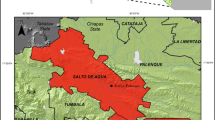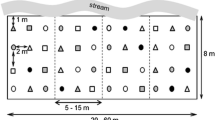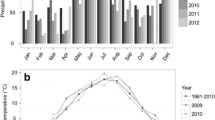Abstract
Restoration of degraded pasture lands in the tropics through afforestation is widely supported. The greatest obstacle to afforestation, however, is the long delay before initial financial returns from wood harvesting are realized. Interplanting young trees with food or energy crops has been proposed as a strategy to help overcome this obstacle. We investigated the impact of this practice on the survival and growth performance of young tropical tree seedlings in Panama. Five native timber tree species and the exotic species Tectona grandis were interplanted with four different crop rotations and monitored over 2 years. Survival of young tree seedlings was up to eight times higher when planted in association with Manihot esculenta. Only during the first 3 months after maize sowing was a significant negative effect of intercropping on tree seedling survival found. Here, survival rate of tree seedlings was up to four times lower than in the pure plantation. Tree growth was not adversely affected by crops. In fact, Astronium graveolens, Cedrela odorata and Terminalia amazonia showed significantly superior growth performance in association with both Zea mays and Cajanus cajan. When combined with the latter, the height increment of these tree species was up to four times that achieved in pure plantations. We conclude that intercropping can be an important silvicultural practice to facilitate forest restoration. Multi-purpose shrubby crop species with cropping cycles of more than 6 months are particularly beneficial, as they quickly shade out grasses, thus reducing the need for herbicides.





Similar content being viewed by others
Notes
In the case of H. alchorneoides, mortality was so high that in some plots less than five of the original seedlings planted were still alive at the end of the observation period (Fig. 2 and OR 1, Table S3 and S4). Though the statistical evidence for treatment effects is, therefore, weak for this species, we have provided the observed values here, as very little empirical data are available on the growth performance of this valuable native tree species in Panama.
More information on infestation rates of C. odorata with H. grandella in this trial can be found in Paul and Weber (2013).
References
Aguirre NM (2007) Silvicultural contributions to the reforestation with native species in the tropical mountain rainforest region of South Ecuador. Dissertation at the Institute of Silviculture, Technische Universität München, Freising, Weihenstephan
Aide TM, Cavelier J (1994) Barriers to lowland tropical forest restoration in the Sierra Nevada de Santa Marta, Colombia. Rest Ecol 2(4):219–229. doi:10.1111/j.1526-100X.1994.tb00054.x
Aide TM, Zimmerman JK, Pascarella JB, Rivera L, Marcano-Vega H (2000) Forest regeneration in a chronosequence of tropical abandoned pastures: implications for restoration ecology. Rest Ecol 8(4):328–338. doi:10.1046/j.1526-100x.2000.80048.x
Ammer C (2003) Growth and biomass partitioning of Fagus sylvatica L. and Quercus robur L. seedlings in response to shading and small changes in the R/FR-ratio of radiation. Ann For Sci 60(2):163–171
ANAM (2010) Guía Técnica de la Reforestación en Panamá. (Manual for the reforestation in Panama). Autoridad Nacional del Ambiente, Panama
ANAM (2011) Atlas Ambiental de la Republica de Panamá. Autoridad Nacional del Ambiente; Gobierno Nacional de la Rebública de Panamá, Panama
Ashton MS, Gunatilleke CVS, Singhakumara BMP, Gunatilleke IAUN (2001) Restoration pathways for rain forest in southwest Sri Lanka: a review of concepts and models. New Dir Trop For Res 154(3):409–430. doi:10.1016/S0378-1127(01)00512-6
Beltrame T, Rodrigues E (2007) Guandu bean (Cajanus cajan) on tropical forest restoration. Feijao (Cajanus cajan) na restraucao de florestas tropicais. Ciencias Agrárias Londrina 28(1):19–28
Bertomeu M (2012) Growth and yield of maize and timber trees in smallholder agroforestry systems in Claveria, northern Mindanao, Philippines. Agrofor Syst 84(1):73–87. doi:10.1007/s10457-011-9444-x
Bradburn MJ, Clark TG, Love SB, Altman DG (2003) Survival analysis part II: multivariate data analysis—an introduction to concepts and methods. Br J Cancer 89(3):431–436. doi:10.1038/sj.bjc.6601119
Ceccon E (2008) Production of bioenergy on small farms: a two-year agroforestry experiment using Eucalyptus urophylla intercropped with rice and beans in Minas Gerais, Brazil. New For 35(3):285–298
Chamshama SAO, Monela GC, Sekiete KEA, Persson A (1992) Suitability of the taungya system at North Kilimanjaro forest plantation, Tanzania. Agrofor Syst 17(1):1–11. doi:10.1007/BF00122924
Clark TG, Bradburn MJ, Love SB, Altman DG (2003) Survival analysis part I: basic concepts and first analyses. Br J Cancer 89(2):232–238. doi:10.1038/sj.bjc.6601118
Collett D (2003) Modelling survival data in medical research, 2nd edn. Chapman & Hall/CRC, Boca Raton
Coomes DA, Allen RB (2007) Effects of size, competition and altitude on tree growth. J Ecol 95(5):1084–1097. doi:10.1111/j.1365-2745.2007.01280.x
Coster C, Hardjowasono M (1935) Influence of agricultural crops in taungya plantations on the growth of teak. Tectona 28:464–487
Current D (1995) Economic and institutional analysis of projects promoting on-farm tree planting in Costa Rica. Costs, benefits, and farmer adoption of agroforestry. Project experience in Central America and the Caribbean. The World Bank, Washington, pp 45–80
Ehiagbonare JE (2006) Effect of Taungya on regeneration of endemic forest tree species in Nigeria: Edo State Nigeria as a case study. Afr J Biotechnol 5(18):1608–1611
ETESA (2011a) El Fenómeno de El Nino en Panamá. http://www.hidromet.com.pa/nino_nina.php. Accessed on 13 Feb 2013
ETESA (2011b) Historical data on mean annual temperature and rainfall in Tortí (1977-2011). http://www.hidromet.com.pa/clima_historicos.php. Accessed on 13 Feb 2013
Evans J, Turnbull JW (2004) Plantation forestry in the tropics. The role, siviculture, and use of planted forests for industrial, social, environmental and agroforestry purposes, 3rd edn. Oxford University Press, Oxford
FAO (2010) Global forest resources assessment 2010. Main report. Food and Agriculture Organization of the United Nations, Rome
Fischer A, Vasseur L (2000) The crisis in shifting cultivation practices and the promise of agroforestry: a review of the Panamanian experience. Biodiv Cons 9(6):739–756. doi:10.1023/A:1008939425511h
Fischer J, Batary P, Bawa KS, Brussaard L, Chappell MJ, Clough Y, Daily GC, Dorrough J, Hartel T, Jackson LE, Klein AM, Kremen C, Kuemmerle T, Lindenmayer DB, Mooney HA, Perfecto I, Philpott SM, Tscharntke T, Vandermeer J, Wanger TC, von Wehrden H (2011) Conservation: limits of land sparing. Science 334(6056):593. doi:10.1126/science.334.6056.593-a
Garen E, Saltonstall K, Slusser J, Mathias S, Ashton M, Hall J (2009) An evaluation of farmers’ experiences planting native trees in rural Panama: implications for reforestation with native species in agricultural landscapes. Agrofor Syst 76(1):219–236
Garen EJ, Saltonstall K, Ashton MS, Slusser JL, Mathias S, Hall JS (2011) The tree planting and protecting culture of cattle ranchers and small-scale agriculturalists in rural Panama: opportunities for reforestation and land restoration. The ecology and ecosystem services of native trees: implications for reforestation and land restoration in Mesoamerica. For Ecol Manag 261(10):1684–1695. doi:10.1016/j.foreco.2010.10.011
Goers L, Lawson J, Garen E (2012) Economic drivers of tropical deforestation for agriculture. In: Ashton MS, Tyrrell ML, Spalding D, Gentry B (eds) Managing forest carbon in a changing climate. Springer, Netherlands, pp 305–320
Griscom HP, Ashton MS (2011) Restoration of dry tropical forests in Central America: a review of pattern and process. The ecology and ecosystem services of native trees: implications for reforestation and land restoration in Mesoamerica. For Ecol Manag 261(10):1564–1579. doi:10.1016/j.foreco.2010.08.027
Griscom HP, Griscom BW, Ashton MS (2009) Forest regeneration from pasture in the dry tropics of Panama: effects of cattle, exotic grass, and forested Riparia. Rest Ecol 17(1):117–126. doi:10.1111/j.1526-100X.2007.00342.x
Günter S, Weber M, Erreis R, Aguirre N (2007) Influence of distance to forest edges on natural regeneration of abandoned pastures: a case study in the tropical mountain rain forest of Southern Ecuador. Eur J For Res 126(1):67–75. doi:10.1007/s10342-006-0156-0
Günter S, Cabrera O, Weber M, Stimm B, Zimmermann M, Fiedler K, Knuth J, Boy J, Wilcke W, Iost S, Makeschin F, Werner F, Gradstein SR, Mosandl R (2008) Natural forest management in neotropical mountain rain forests—an ecological experiment. In: Beck E, Bendix J, Kottke I, Makeschin F, Mosandl R, Caldwell MM, Heldmaier G, Jackson RB, Lange OL, Mooney HA, Schulze E, Sommer U (eds) Gradients in a tropical mountain ecosystem of ecuador, vol 198. Springer, Berlin, pp 347–359
Haggar J, Rheingans R, Arroyo P, Alvarado B (2003) Benefits and costs of intercropping reforestation in the Atlantic lowlands of Costa Rica. New For 25(1):41–48
Holdridge LR (1967) Life zone ecology, Revised edn. Tropical Science Center, San José
Holl KD (2007) Old field vegetation succession in the neotropics. In: Cramer V, Hobbs RJ (eds) Old fields: dynamics and restoration of abandoned farmland. Island Press, Washington
Imo M (2009) Interactions amongst trees and crops in taungya systems of western Kenya. Agrof Syst 76(2):265–273. doi:10.1007/s10457-008-9164-z
INEC (2011) VII Censo Nacional Agropecuario 2011. Resultados Finales Básicos. Instituto Nacional de Estadística y Censo, Contraloría General de la República de Panamá
Jordan CF (ed) (1992) Taungya. Forest plantations with agriculture in Southeast Asia. CAB International, Wallingford
Kapp G, Beer J (1995) A comparison of agrisilvicultural systems with plantation forestry in the Atlantic Lowlands of Costa Rica. Agrof Syst 32:207–223
Khybri M, Gupta R, Ram S, Tomar H (1992) Crop yields of rice and wheat grown in rotation as intercrops with three tree species in the outer hills of Western Himalaya. Agrof Syst 17(3):193–204. doi:10.1007/BF00054147
Kikvidze Z, Armas C (2010) Plant interaction indices based on experimental plant performance data. In: Pugnaire FI (ed) Positive plant interactions and community dynamics. CRC Press; Fundación BBVA, Boca Raton, pp 17–38
Kiriinya C (1994) Comparative growth of seven years old Grevillea robusta A. cunn. grown under Taungya system and pure plantation. J Trop For 10(1)
Knoke T, Huth A (2011) Modelling forest growth and finance: often disregarded tools in tropical land management. In: Günter S, Weber M, Stimm B, Mosandl R (eds) Silviculture in the tropics, vol 8. Springer, Berlin, pp 129–142
Knoke T, Calvas B, Moreno SO, Onyekwelu JC, Griess VC (2013) Food production and climate protection—What abandoned lands can do to preserve natural forests. Global Env Change 23(5):1064–1072. doi:10.1016/j.gloenvcha.2013.07.004
Kreuzer S (2013) Untersuchungen zur Konkurrenz sowie zur Interaktion zwischen Cajanus Cajan und sechs verschiedneen tropischen Wertholzarten in Panama. Master thesis, Institute of Silviculture, Technische Universität München, Freising
Kuusipalo J, Ådjers G, Jafarsidik Y, Otsamo A, Tuomela K, Vuokko R (1995) Restoration of natural vegetation in degraded Imperata cylindrica grassland: understorey development in forest plantations. J Veg Sc 6(2):205–210. doi:10.2307/3236215
Lamb D, Erskine PD, Parrotta JA (2005) Restoration of degraded tropical forest landscapes. Science 310(5754):1628–1632
Langton S (1990) Avoiding edge effects in agroforestry experiments; the use of neighbour-balanced designs and guard areas. Agrofor Syst 12(2):173–185. doi:10.1007/BF00123472
Loss A, Pereira MG, Ferreira EP, Santos LLd, Beutler SJ, Ferraz Júnior ASdL (2009) Frações oxidáveis do carbono orgânico em argissolo vermelho-amarelo sob sistema de aleias. Revista Brasileira de Ciência do Solo 33:867–874
Marin W, Flores E (2002) Dalbergia retusa—species description. In: Vozzo J (ed) Tropical tree seed manual. USDA Forest Service, Washington, DC
Martin F, van Noordwijk M (2009) Trade-offs analysis for possible timber-based agroforestry scenarios using native trees in the Philippines. Agrofor Syst 76:555–567. doi:10.1007/s10457-009-9208-z
Mermut A, Dasog G, Dowuona G (1996) Soil morphology. In: Ahmad N, Mermut A (eds) Vertisols and technologies for their management. Elsevier, Amsterdam
Moran EF, Brondizio ES, Tucker JM, da Silva-Forsberg MC, McCracken S, Falesi I (2000) Effects of soil fertility and land-use on forest succession in Amazônia. For Ecol Manag 139(1–3):93–108. doi:10.1016/S0378-1127(99)00337-0
Nair PK, Buresh RJ, Mugendi D, Latt C (1999) Nutrient cycling in tropical agroforestry systems: myths and science. In: Buck L, Lassoie JP, Fernandes ECM (eds) Agroforestry in sustainable agricultural systems. CRC Press, Boca Raton
Norgrove L, Hauser S (2002) Measured growth and tree biomass estimates of Terminalia ivorensis in the 3 years after thinning to different stand densities in an agrisilvicultural system in southern Cameroon. For Ecol Manag 166(1–3):261–270. doi:10.1016/S0378-1127(01)00614-4
Oelmann Y, Potvin C, Mark T, Werther L, Tapernon S, Wilcke W (2010) Tree mixture effects on aboveground nutrient pools of trees in an experimental plantation in Panama. Plant Soil 326(1):199–212. doi:10.1007/s11104-009-9997-x
Onyekwelu J, Stimm B, Evans J (2011) Review Plantation Forestry. In: Günter S, Weber M, Stimm B, Mosandl R (eds) Silviculture in the Tropics, vol 8. Springer, Berlin, pp 399–454
Palomeque FP (2012) Natural succession and tree plantation as alternatives for restoring abandoned lands in the Andes of Southern Ecuador: aspects of facilitation and competition. Dissertation, Technische Universität München
Paul C (2014) Timber-based agrisilvicultural systems to facilitate reforestation in Panama—a silvicultural and economic evaluation. Dissertation, Technische Universität München
Paul C, Weber M (2013) Intercropping Cedrela odorata with shrubby crop species to reduce infestation with Hypsipyla grandella and improve the quality of timber. ISRN Forestry 2013:10. doi:10.1155/2013/637410
Paul C, Griess V, Havardi-Burger N, Weber M (2014) Timber-based agrisilviculture improves financial viability of hardwood plantations: a case study from Panama. Agrofor Syst. doi:10.1007/s10457-014-9755-9
Peterson St-Laurent G, Gélinas N, Potvin C (2013) Diversity of perceptions on REDD + implementation at the agriculture frontier in Panama. Int J For Res 2013:16. doi:10.1155/2013/657846
Piepho HP, Büchse A, Emrich K (2003) A Hitchhiker’s guide to mixed models for randomized experiments. J Agr Crop Sc 189(5):310–322. doi:10.1046/j.1439-037X.2003.00049.x
Piotto D, Montagnini F, Ugalde L, Kanninen M (2003) Performance of forest plantations in small and medium-sized farms in the Atlantic lowlands of Costa Rica. For Ecol Manag 175(1–3):195–204
Piotto D, Viquez E, Montagnini F, Kanninen M (2004) Pure and mixed forest plantations with native species of the dry tropics of Costa Rica: a comparison of growth and productivity. For Ecol Manag 190(2–3):359–372. doi:10.1016/j.foreco.2003.11.005
Potvin C, Dutilleul P (2009) Neighborhood effects and size-asymmetric competition in a tree plantation varying in diversity. Ecology 90(2):321–327. doi:10.1890/08-0353.1
Prasad J, Korwar G, Rao K, Mandal U, Rao C, Rao G, Ramakrishna Y, Venkateswarlu B, Rao S, Kulkarni H, Rao M (2010) Tree row spacing affected agronomic and economic performance of Eucalyptus-based agroforestry in Andhra Pradesh, Southern India. Agrofor Syst 78(3):253–267. doi:10.1007/s10457-009-9275-1
Pretzsch H (2009) Forest dynamics, growth and yield. From measurement to model. Springer, Berlin
Quinn GP, Keough MJ (2002) Experimental design and data analysis for biologists. Cambridge University Press, Cambridge
Rao M, Nair P, Ong C (1997) Biophysical interactions in tropical agroforestry systems. Agrofor Syst 38(1):3–50. doi:10.1023/A:1005971525590
Schlönvoigt A, Beer J (2001) Initial growth of pioneer timber tree species in a Taungya system in the humid lowlands of Costa Rica. Agrofor Syst 51(2):97–108. doi:10.1023/A:1010674402907
Schuchmann J (2011) A participatory survey on current integration of trees on farms and pastures within land use systems in the township of Tortí in Panama: Bachelor thesis, Institute of Silviculture, Technische Universität München, Freising, Weihenstephan
Sloan S (2008) Reforestation amidst deforestation: simultaneity and succession. Globalisation and environmental governance: Is another world possible? Global Env Change 18(3):425–441
Somarriba E, Valdivieso R, Vásquez W, Galloway G (2001) Survival, growth, timber productivity and site index of Cordia alliodora in forestry and agroforestry systems. Agrofor Syst 51(2):111–118
van Breugel M, Hall JS, Craven DJ, Gregoire TG, Park A, Dent DH, Wishnie MH, Mariscal E, Deago J, Ibarra D, Cedeño N, Ashton MS (2011) Early growth and survival of 49 tropical tree species across sites differing in soil fertility and rainfall in Panama. The ecology and ecosystem services of native trees: implications for reforestation and land restoration in Mesoamerica. For Ecol Manag 261(10):1580–1589. doi:10.1016/j.foreco.2010.08.019
Vandermeer JH (1989) The ecology of intercropping. Cambridge University Press, Cambridge
Vieira DLM, Holl KD, Peneireiro FM (2009) Agro-successional restoration as a strategy to facilitate tropical forest recovery. Rest Ecol 17(4):451–459. doi:10.1111/j.1526-100X.2009.00570.x
Young A (1997) Agroforestry for soil management, 2nd edn. CAB International and ICRAF, New York
Zimmermann JK (2002) Barriers to forest regeneration in an abandoned pasture in Puerto Rico. Rest Ecol 8(4):350–360
Acknowledgments
The authors are grateful to the German Research Foundation (DFG) (Project WE 2069/6-1), the Elite Network of Bavaria and the program “Equal Opportunity for Women in Research and Teaching” by the Technische Universität München for funding this work. This project was furthermore supported by the Forest Finance Group that provided land and labor as well as BARCA SA who provided logistic help. The authors furthermore wish to thank Donna Ankerst for support with statistical analysis and Jörg Prietzel, Peter Schad, Carlos Him and Manuela Theobald for help with analysis of soil samples and all students who helped with measurements. We are grateful to Thomas Knoke for continuous support and collaboration in this project. The authors also thank Laura Carlson for language editing. Finally we would like to express our gratitude to the Editors and two anonymous referees for their valuable suggestions on an earlier version of this manuscript.
Conflict of interest
None declared.
Author information
Authors and Affiliations
Corresponding author
Electronic supplementary material
Below is the link to the electronic supplementary material.
Rights and permissions
About this article
Cite this article
Paul, C., Weber, M. Effects of planting food crops on survival and early growth of timber trees in eastern Panama. New Forests 47, 53–72 (2016). https://doi.org/10.1007/s11056-015-9477-5
Received:
Accepted:
Published:
Issue Date:
DOI: https://doi.org/10.1007/s11056-015-9477-5




